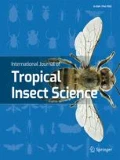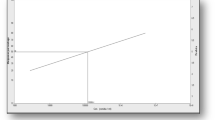Abstract
The sensitivity of different larval stage duration pupae of Mediterranean fruit-fly, Ceratitis capitata to gamma irradiation, was tested by exposing pupae, 1 day before adult eclosion, to various gamma ray doses (60, 80 and 100 Gy). The treated pupae were biologically different in their larval span (5, 7 and 9 days). The pupae of med-fly having shorter larval period (5 days) were more resistant to sterilizing effects of gamma irradiation than those having longer larval period (9 days). The longevity of sterilized females developing from irradiated pupae, which had 5-and 7-day larval span, was increased considerably. Treatment of pupae which had 5-day larval span with a dose of 80 Gy, resulted in females which lived 84.3 days, but laid only 2.33 eggs as compared with their control females which lived 51.4 days and laid 976.71 eggs. In general, irradiation of pupae of different larval stage duration with a dose of 60 Gy or greater did not adversely affect the longevity of emerging adults. It is concluded that 60 Gy-irradiation of pupae having long larval span (9 days) should be used in the sterile insect release method for population suppression of Ceratitis capitata.
Résumé
— La sensibilité de pupes de la monche Meditereneenne Ceratitis capitata de différentes duréés de stades larveins aux radietions gamme a eté testée en exposant les pupes un jour avent l’eciosion de l’adulte, 3 différents dose de Rayons gamme (60, 80 t 100 Gy) les pupes treites étaient biologiquement différents doses la durée du stade larvaine (5, 7 et 9 joures). Les pupes de la monche Mediteraneenne obéenus issues après na plus counte période larvaine (5 jours) étaient plus résistants aux effects stérilisants des radiation gamma que cells syamt une plus longu un période larveine (9 jours). La longévité des femelles stérilisés issues de pupes iriadies qui avaient 5 et 7 jours de durée larveine ‘éteient considérablement accune. Le treitement de pupes qui aveient une durée larveine de 5 jours, avec une dose de 80 Gy donineit de femelles vivent 84.3 jours en gamme un déposent qui 2,33 oeuls en royenn pav compereisan avec les femelles traitées qui vivant 51.4 jours et déposent 976,71 oents. En général, l’irradiation des pupes de différents durées due stede larvaine avec une doses de 60 Gy ou plus n’effecten pes au contreir la longévité de adults emergeants.
En conclusion une irradiation de 60 Gy de pupes longue durée (9 jours doit etre utilisen dens une methode de Lêdur de seuches sterile pemr la supperssions de population de Ceratitis capitata.
Similar content being viewed by others
References
Awadallah A.M. and El-Hakim Aida M. (1987) Methods for mass production of the Mediterranean fruit-fly Ceratitis capitata (Wied.). Methods for producing adults. Zagazig J. Agric. Res. 14, 862–872.
Brower J.H. (1980) Comparative radiosensitivity of field collected and laboratory strains of the Indian meal moth. J. Georgia Ent. Soc. 15, 439–445.
Causse R., Feron M. and Pereau-Leroy P. (1968) Effect compares d’irradiations aux rayons gamma et aux neutrons sur les organes reproducteurs de la mouche Méditerranéenne de fruits, Ceratitis capitata (Wied.) (Diptera; Trypetidae). In Isotopes and Radiation in Entomology. Proc. Symposium, Vienna, 1967 IAEA, Vienna, pp. 355–364.
Ezzat M.A. (1966) Induced sterility in males of Mediterranean fruit-fly, Ceratitis capitata (Wied.) as a means of controlling and possibly eradicating that pest. Final report on pl-480 Project, F4. Ent. J. Egypt, Ministry of Agric, Egypt ARE.
Feron M. (1964) Laboratory studies on the effect of gamma radiation on the Mediterranean fruit-fly. Report on the Panel on the “Advances in Insect Population Control by the Sterile-Male Technique” held in Vienna, Austria, July 1964, IAEA. Tech. Ser. 44.
Feron M. (1966) Sterilization de la mouche Mediterranean de fruits, Ceratitis capitata (Wied.) par irradiation des pupes aux rayons gamma. Ann. Epiphyt. (Paris) 17, 229–239.
Fisher R.A. (1950) Statistical Methods for Research Workers. Olive. and Boyd. Edinburgh, England.
Gagliani M. (1952) Durata del ciclo larvale in ceppi di Musco domestica L. sensibilie resistami al DDT. Bolletino Della Società Italiana Di Biologi a Sperimentate 26, 326–328.
Proshold RI. and Baiteli J.A. (1972) Difference in radiosensitivity of two colonies of tobacco budworms. Heliothis virescens (Lepidoptera: Noctuidae). Can. Ent. 104, 995–1002.
Rhode R.H. (1970) Application of the sterile-male technique in Mediterranean fruit fly suppression; A follow-up experiment in Nicaragua. In Proc. Panel on Sterile-Male Technique for Control of Fruit Flies, 175 p. Int. At. Energy Agency, Vienna, Austria, p. 43–50.
Steiner L.F., Mitchell W.C. and Baumhover A.H. (1962) Progress of fruit-fly control by irradiation sterilization in Hawaii and the Mariana Island. Int. J. Appl. Radiai. Isot. 13, 427–434.
Thomou H. (1963) Sterilization of Dacus oleae gamma radiation. In Radiation and Radio-isotopes Applied to Insects of Agricultural Importance. Proc. Symp., Athens, 22–26 April, 1963, IAEA/FAO, Vienna 1963. pp. 413–424.
Weidhass D.E., Schmidt C.H. and Chamberlain W.F. (1962) Research on radiation in insect control. Radioisotopes and Radiation in Entomology. Proc. Symp., Bombay, 5–9 December 1960, IAEA. pp. 257–265.
Wolfenbarger D.A. and Guerra A.A. (1971) Response of strains and sexes of the tobacco budworm to gamma irradiation. J. econ. Ent. 64, 1412–1415.
Author information
Authors and Affiliations
Rights and permissions
About this article
Cite this article
El-Hakim, A.M., Abdel-Salam, K.A. Radiosensitivity of Different Larval Stage Duration Pupae of the Mediterranean Fruit-Fly, Ceratitis capitata Wied.. Int J Trop Insect Sci 10, 69–74 (1989). https://doi.org/10.1017/S1742758400003362
Received:
Revised:
Published:
Issue Date:
DOI: https://doi.org/10.1017/S1742758400003362



